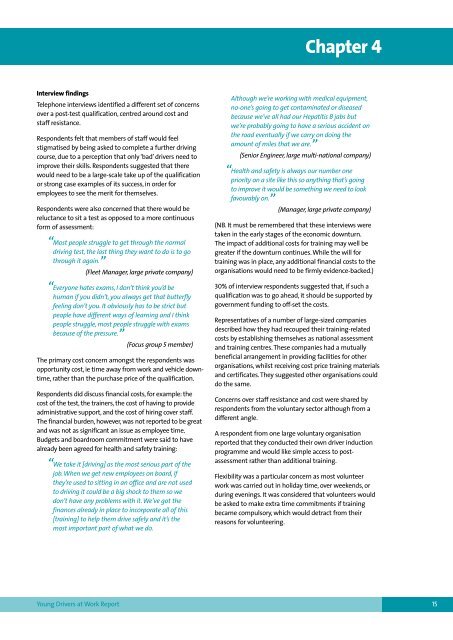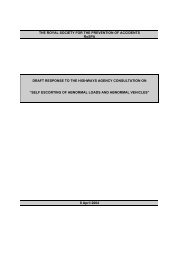RoSPA Young Drivers at Work Report
RoSPA Young Drivers at Work Report
RoSPA Young Drivers at Work Report
Create successful ePaper yourself
Turn your PDF publications into a flip-book with our unique Google optimized e-Paper software.
Chapter 4<br />
Interview findings<br />
Telephone interviews identified a different set of concerns<br />
over a post-test qualific<strong>at</strong>ion, centred around cost and<br />
staff resistance.<br />
Respondents felt th<strong>at</strong> members of staff would feel<br />
stigm<strong>at</strong>ised by being asked to complete a further driving<br />
course, due to a perception th<strong>at</strong> only ‘bad’ drivers need to<br />
improve their skills. Respondents suggested th<strong>at</strong> there<br />
would need to be a large-scale take up of the qualific<strong>at</strong>ion<br />
or strong case examples of its success, in order for<br />
employees to see the merit for themselves.<br />
Respondents were also concerned th<strong>at</strong> there would be<br />
reluctance to sit a test as opposed to a more continuous<br />
form of assessment:<br />
“Most people struggle to get through the normal<br />
driving test, the last thing they want to do is to go<br />
through it again. ”<br />
(Fleet Manager, large priv<strong>at</strong>e company)<br />
“Everyone h<strong>at</strong>es exams, I don’t think you’d be<br />
human if you didn’t, you always get th<strong>at</strong> butterfly<br />
feeling don’t you. It obviously has to be strict but<br />
people have different ways of learning and I think<br />
people struggle, most people struggle with exams<br />
because of the pressure. ”<br />
(Focus group 5 member)<br />
The primary cost concern amongst the respondents was<br />
opportunity cost, ie time away from work and vehicle downtime,<br />
r<strong>at</strong>her than the purchase price of the qualific<strong>at</strong>ion.<br />
Respondents did discuss financial costs, for example: the<br />
cost of the test, the trainers, the cost of having to provide<br />
administr<strong>at</strong>ive support, and the cost of hiring cover staff.<br />
The financial burden, however, was not reported to be gre<strong>at</strong><br />
and was not as significant an issue as employee time.<br />
Budgets and boardroom commitment were said to have<br />
already been agreed for health and safety training:<br />
“We take it [driving] as the most serious part of the<br />
job.When we get new employees on board, if<br />
they’re used to sitting in an office and are not used<br />
to driving it could be a big shock to them so we<br />
don’t have any problems with it.We’ve got the<br />
finances already in place to incorpor<strong>at</strong>e all of this<br />
[training] to help them drive safely and it’s the<br />
most important part of wh<strong>at</strong> we do.<br />
“Although we’re working with medical equipment,<br />
no-one’s going to get contamin<strong>at</strong>ed or diseased<br />
because we’ve all had our Hep<strong>at</strong>itis B jabs but<br />
we’re probably going to have a serious accident on<br />
the road eventually if we carry on doing the<br />
amount of miles th<strong>at</strong> we are. ”<br />
(Senior Engineer, large multi-n<strong>at</strong>ional company)<br />
“Health and safety is always our number one<br />
priority on a site like this so anything th<strong>at</strong>’s going<br />
to improve it would be something we need to look<br />
favourably on. ”<br />
(Manager, large priv<strong>at</strong>e company)<br />
(NB. It must be remembered th<strong>at</strong> these interviews were<br />
taken in the early stages of the economic downturn.<br />
The impact of additional costs for training may well be<br />
gre<strong>at</strong>er if the downturn continues.While the will for<br />
training was in place, any additional financial costs to the<br />
organis<strong>at</strong>ions would need to be firmly evidence-backed.)<br />
30% of interview respondents suggested th<strong>at</strong>, if such a<br />
qualific<strong>at</strong>ion was to go ahead, it should be supported by<br />
government funding to off-set the costs.<br />
Represent<strong>at</strong>ives of a number of large-sized companies<br />
described how they had recouped their training-rel<strong>at</strong>ed<br />
costs by establishing themselves as n<strong>at</strong>ional assessment<br />
and training centres. These companies had a mutually<br />
beneficial arrangement in providing facilities for other<br />
organis<strong>at</strong>ions, whilst receiving cost price training m<strong>at</strong>erials<br />
and certific<strong>at</strong>es. They suggested other organis<strong>at</strong>ions could<br />
do the same.<br />
Concerns over staff resistance and cost were shared by<br />
respondents from the voluntary sector although from a<br />
different angle.<br />
A respondent from one large voluntary organis<strong>at</strong>ion<br />
reported th<strong>at</strong> they conducted their own driver induction<br />
programme and would like simple access to postassessment<br />
r<strong>at</strong>her than additional training.<br />
Flexibility was a particular concern as most volunteer<br />
work was carried out in holiday time, over weekends, or<br />
during evenings. It was considered th<strong>at</strong> volunteers would<br />
be asked to make extra time commitments if training<br />
became compulsory, which would detract from their<br />
reasons for volunteering.<br />
<strong>Young</strong> <strong>Drivers</strong> <strong>at</strong> <strong>Work</strong> <strong>Report</strong><br />
15
















